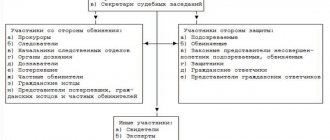1. Criminal cases may be combined in one proceeding against: 1) several persons who have committed one or more crimes in complicity; 2) one person who has committed several crimes; 3) a person accused of concealing crimes that were not promised in advance and are being investigated in these criminal cases.
2. The connection of criminal cases is also permitted in cases where the person to be charged as an accused has not been identified, but there are sufficient grounds to believe that several crimes were committed by one person or group of persons.
3. The connection of criminal cases being processed by the investigator is carried out on the basis of a resolution of the head of the investigative body. The combination of criminal cases under investigation by the investigator is carried out on the basis of a decision of the prosecutor. The decision to combine criminal cases of crimes investigated in accordance with Articles 150 and 151 of this Code by different preliminary investigation bodies is made by the head of the investigative body based on the decision of the prosecutor to determine jurisdiction. If the preliminary investigation is carried out in the form of an inquiry, the said decision is made by the prosecutor.
4. When combining criminal cases, the period for proceedings on them is determined by the criminal case that has the longest period of preliminary investigation. At the same time, the period of proceedings in other criminal cases is absorbed by the longest period and is not additionally taken into account.
Article 153 of the Code of Criminal Procedure of the Russian Federation. Connection of criminal cases (current edition)
1. The connection of criminal cases as a general condition of the preliminary investigation ensures its comprehensiveness, objectivity and completeness. For these purposes, the investigative body combines two or more criminal cases in one proceeding if there are grounds specified in the commented article.
2. Comprehensiveness, objectivity and completeness of the investigation should not conflict with other principles of the criminal process. Thus, the exercise of the accused’s right to defense is possible only against an individual, specific accusation. An endless investigation into the accused’s “dark past” would practically deprive him of this procedural right. An excessive requirement to disclose all crimes committed by all persons is contrary to the right to be tried without undue delay (clause “c” of Part 3 of Article 14 of the Covenant on Civil and Political Rights). Unreasonably combining cases is fraught with the risk of turning the proceedings into a multi-volume paper “monster”, delaying the process and violating the deadlines for the investigation, trial, and detention. For this reason, unlike the Code of Criminal Procedure of the RSFSR of 1960, in the current Code, the connection of cases no longer enjoys clear priority over their separation. However, the Code of Criminal Procedure as amended. The Federal Law of July 4, 2003 granted the judge the right to return the case to the prosecutor if there are grounds for joining the cases (clause 4, part 1, article 237). As a result, this norm has become, in a sense, a sanction for not joining cases during the preliminary investigation.
3. As a rule, to connect cases, it is necessary to prove the participation of persons in the commission of crimes. Therefore, the cases are joined against the accused (after a decision has been made to charge them as an accused). As an exception, the law does not prohibit joining cases against suspects and even against unidentified persons. At the same time, it should be noted that due to the presumption of innocence, the accused is considered innocent of committing a crime until the court verdict enters into legal force. Therefore, when connecting cases, it is unlawful, in our opinion, to talk about the commission of crimes by the accused, and especially by the suspects, as is done in Part 1 of the commented article. Its provisions should be interpreted restrictively, for example, to speak not about the commission of several crimes by one person (clause 2 of part 1 of the commented article), but about the fact that a person has the procedural status of an accused or suspect in several criminal cases, etc. Part 2 of the commented article gives the right to join cases against unidentified persons if there is evidence that crimes were committed by the same person or the same group. This may be evidence about a specific method of committing a crime, the subject of the crime (for example, belonging to one batch of counterfeit money).
A special type of connection of cases is the combination in one proceeding of counter-statements in a private prosecution case (Part 3 of Article 321 of the Code of Criminal Procedure).
It is not allowed to join cases on other grounds (common criminal results of careless acts of non-participants; careless storage of weapons and use of them by another person).
4. The condition for connection is the presence of the cases themselves that have been initiated and under investigation, since only criminal cases, but not materials, can be combined in one proceeding. The following rules follow from this condition: a) cases suspended and terminated cannot be combined without correspondingly resuming the case or canceling the decision to terminate the case; b) if during the investigation a new crime is discovered (event, fact for which the case was not initially initiated), then it is necessary first in accordance with Art. 146 of the Code of Criminal Procedure, make a decision to initiate a new case, and then combine them in one proceeding. See comment about this. to Art. 146.
5. Part 3 of the commented article (as amended by Federal Law No. 87-FZ of June 5, 2007) established that the connection of cases is allowed on the basis of a resolution of the head of the investigative body. However, Part 7 of Art. 151 of the Code of Criminal Procedure gives the prosecutor the authority to determine the jurisdiction of a case when combining in one proceeding criminal cases that are under investigation by different preliminary investigation bodies. The use of the term “preliminary investigation” allows us to conclude that the connection of cases is possible in any form of investigation, including during an inquiry. The decision to join criminal cases investigated in the form of an inquiry, within the meaning of the law, is made by the prosecutor.
Comment source:
Ed. A.V. Smirnova “COMMENTARY ON THE CRIMINAL PROCEDURE CODE OF THE RUSSIAN FEDERATION” (ARTICLE BY ARTICLE), 5th edition
SMIRNOV A.V., KALINOVSKY K.B., 2009
The Constitutional Court recognized the relationship between the issues of combining criminal cases and the period of detention
On January 14, the Constitutional Court issued Ruling No. 6-O in the case of verification of Art. 109 of the Code of Criminal Procedure of the Russian Federation, which regulates the terms of detention and the procedure for their extension by the court.
Reason for applying to the Constitutional Court
On March 6, 2022, Alexander Efimov was detained by law enforcement agencies on suspicion of committing fraud under Part 4 of Art. 159 of the Criminal Code of the Russian Federation. On March 9, the Vsevolozhsk City Court chose a preventive measure for him in the form of detention; subsequently, it was repeatedly extended for 12 months - until March 5, 2022. But on March 1, the St. Petersburg City Court refused to satisfy the investigator’s next request for an extension and ordered place Efimov under house arrest. The ruling was subsequently upheld on appeal. Both authorities considered that the investigation of the criminal case was actually completed and the accused, together with his defense attorneys, began to get acquainted with the materials of the case, therefore the circumstances taken into account when choosing and extending the previous preventive measure changed significantly and lost their relevance.
At the same time, the investigative department of the Ministry of Internal Affairs of Russia for the Vsevolozhsk region was processing another criminal case on the grounds of a crime under Part 4 of Art. 159 of the Criminal Code of the Russian Federation, which was initiated on February 27, 2022. Subsequently, the investigation into it was suspended due to the inability to identify the accused. However, on February 25, 2022, it was resumed, and on March 1, Alexander Efimov was detained on suspicion of committing this crime, and the very next day the court again ordered his detention.
The term of the new preventive measure was calculated independently (regardless of the time the citizen was held in custody in the first case) and was repeatedly extended by the court with reference to Efimov’s dual citizenship, several foreign passports, and his ability to influence witnesses to change their testimony.
The defense unsuccessfully tried to draw the attention of the appeal to the fact that when choosing a preventive measure in the form of detention in a new criminal case, the terms of the previous detention of a citizen in a pre-trial detention center in another criminal case should be taken into account.
Contents of the complaint to the Constitutional Court of the Russian Federation
On August 27, 2022, lawyer at Lapinsky and Partners Konstantin Kuzminykh, defending Alexander Efimov, sent a complaint to the Constitutional Court (available from AG), in which he indicated that Art. 109 “Terms of detention” of the Code of Criminal Procedure of the Russian Federation does not correspond to the Basic Law due to its uncertainty in terms of establishing the period of detention of an accused whose criminal prosecution is carried out in two or more criminal cases. According to the applicant, such a defect in the contested article entails a violation of its second part on the inadmissibility of exceeding the maximum (12 months) period of this preventive measure.
Art. 153 Code of Criminal Procedure of the Russian Federation with comments
The above norm is not fully disclosed and requires answers to many questions.
It is possible to combine criminal cases if the person who committed the crime is the accused in one material, and is listed as a victim in another.
In addition, it is not necessary to combine cases. The authorized person first establishes all the facts of the crime, and then makes a decision. Only those cases whose investigation will be mutually easier and faster than separately can be combined.
The basis for the connection cannot be the persons participating in the case.
If episodes of the same case are being investigated by different authorities, the prosecutor has the right to make a decision to combine criminal cases and transfer it according to jurisdiction.
To establish the timing of the preliminary investigation of combined cases, no special act is required.
Art. 153 “Connection of criminal cases”
An official has the right to connect them in cases where:
- two or more citizens are involved in the commission of an unlawful act or acts;
- one citizen committed several crimes;
- some episodes were hidden.
Criminal cases initiated after the fact (that is, without identifying the person) can also be combined if the same handwriting of the criminal is observed. For example, marked banknotes or other traces specific to that particular person are left at the crime scene.
The decision to join criminal cases is made by the investigator or inquiry officer. The head of the investigative body or the prosecutor has the right to approve the decision. The procedure is carried out by signing a resolution on the consolidation of criminal cases.
How it goes
The combination of criminal cases into one judicial proceeding occurs through the actions of the investigator and the interrogating officer.
- a number of citizens who committed a single, certain number of legal violations;
- an object that has committed many legal violations, thefts, murders;
- a person who is accused of deliberately concealing particularly serious illegal acts being investigated for this criminal violation.
Connection is allowed in the event of failure to identify the object, which automatically becomes the accused, and there is ample justification for the assumption that the law-violating actions committed by the object are a number of citizens.
The legislation gives the right to connect cases against unidentified persons if there is evidence of a crime committed by a citizen or group. This may be evidence - of a specific method, subject related to the offense committed.
There is no reason to combine legal cases if there is no totality of criminal results of careless actions of people who are not involved in one crime or attack on a specific object.
- Discontinued cases.
- Suspended cases.
Grouping is a general condition for preliminary investigations, which ensures its comprehensive, objective completeness.
After the latest update of the legislation comes into force, if suitable circumstances exist, the connection of criminal cases by the court occurs independently, without prosecutorial intervention.
Nuances
In accordance with the second part of Article 153 of the Criminal Procedure Code, materials drawn up on the fact, but containing information about the persons involved, can be combined. Evidence can be substances, objects, audio and video recordings, and the method of committing a crime. For example, if a citizen leaves identical ancient coins at the scene of a crime.
Counter-statements can serve as a type of combining materials into one case (this rule applies only to private accusations).
Connection order
The person who has the right to certify the decision to join criminal cases is the head of the investigative body (hereinafter referred to as the CO) or the prosecutor, in the case of an investigation by an investigator. The head of the investigation team carries out the procedural action if the outcome is positive after the prosecutor has examined the case.
Based on Art. 153 of the Code of Criminal Procedure of the Russian Federation, an act is formed that includes the following elements:
- indication of the date and city of the decision;
- information about the authorized person who made the decision (last name, first name and patronymic, government body, rank);
- information on the fact of the crime;
- list of procedural actions performed;
- grounds for joining criminal cases with reference to the law.
If any element of the resolution is incorrectly indicated, the prosecutor has the right to cancel it or send it for revision within the period established by law.
The document is signed by the head of the investigative body or inquiry. The investigation can independently make this decision, which distinguishes it from the inquiry. The prosecutor's office has great powers in relation to investigators, therefore the approval of a resolution to join criminal cases is made with the permission of the prosecutor.
Connection and separation of criminal cases, separation of criminal case materials into separate proceedings
The grounds for joining criminal cases are listed in Part 1 of Art. 153 Code of Criminal Procedure of the Russian Federation. Criminal cases can be connected in relation to:
1) several persons who have committed one or more crimes in complicity;
2) one person who has committed several crimes;
3) a person accused of concealing crimes that were not promised in advance and are being investigated in these criminal cases.
The connection of criminal cases is also allowed in cases where the person to be charged as an accused has not been identified, but there are sufficient grounds to believe that several crimes were committed by one person or group of persons. Quite often, this type of connection occurs in cases of counterfeiting.
The connection of criminal cases being processed by the investigator is carried out on the basis of a resolution of the head of the investigative body. The combination of criminal cases under investigation by the investigator is carried out on the basis of a decision of the prosecutor. The decision to combine criminal cases of crimes under investigation by different preliminary investigation bodies is made by the head of the investigative body based on the decision of the prosecutor to determine jurisdiction. If the preliminary investigation is carried out in the form of an inquiry, the said decision is made by the prosecutor.
When combining criminal cases, the period for proceedings on them is determined by the criminal case that has the longest period of preliminary investigation. At the same time, the period of proceedings in other criminal cases is absorbed by the longest period and is not additionally taken into account.
The grounds for singling out criminal cases are listed in Part 1 of Art. 154 Code of Criminal Procedure of the Russian Federation. The inquiry officer or investigator has the right to separate another criminal case from a criminal case into separate proceedings in relation to:
1) individual suspects or accused in criminal cases of crimes committed in complicity, in cases of suspension of the criminal case;
2) a minor suspect or accused brought to criminal liability together with adult accused;
3) other persons suspected or accused of committing a crime not related to the acts charged in the criminal case under investigation, when this becomes known during the preliminary investigation;
4) a suspect or accused with whom the prosecutor has entered into a pre-trial cooperation agreement. In the event of a threat to the safety of the suspect or accused, the materials of the criminal case identifying his identity are withdrawn from the criminal case initiated and added to the criminal case against the suspect or accused, separated into separate proceedings;
5) individual suspects in respect of whom the preliminary investigation is carried out in the form of an abbreviated inquiry, if in relation to other suspects or accused the preliminary investigation is carried out in the general manner.
Separation of a criminal case into a separate proceeding to complete the preliminary investigation is permitted if this does not affect the comprehensiveness and objectivity of the preliminary investigation and resolution of the criminal case, in cases where this is caused by the large volume of the criminal case or the multiplicity of its episodes.
The separation of a criminal case is carried out on the basis of a decision of the investigator or inquiry officer. If a criminal case is separated into separate proceedings for the purpose of conducting a preliminary investigation of a new crime or against a new person, then the resolution must contain a decision to initiate a criminal case in accordance with the procedure.
A criminal case separated into separate proceedings must contain originals or copies of procedural documents relevant to this criminal case certified by the investigator or inquiry officer.
The period of preliminary investigation in a criminal case separated into separate proceedings is calculated:
- from the date of the relevant decision, when a criminal case is opened for a new crime or against a new person;
- from the moment of initiation of the criminal case from which it was separated into separate proceedings.
The separation of a criminal case should be distinguished from the separation of the materials of a criminal case into separate proceedings, which, according to Part 1 of Art. 155 of the Code of Criminal Procedure of the Russian Federation arises if, during the preliminary investigation, it becomes known that other persons have committed a crime that is not related to the crime under investigation.
The selection of materials containing information about a new crime is carried out by the investigator or interrogating officer, about which he makes a decision. Materials from the initial criminal case are photocopied and sent for a decision in accordance with Articles 144 and 145 of the Code of Criminal Procedure of the Russian Federation: the investigator sends the materials to the head of the investigative body, and the investigator sends them to the prosecutor. In practice, these documents are supplemented with a report from the investigator or inquiry officer on the discovery of signs of a crime, which is recorded in the KUSP journal.
Materials containing information about a new crime and separated from the criminal case into separate proceedings are admitted as evidence in this criminal case.
The grounds for joining criminal cases are listed in Part 1 of Art. 153 Code of Criminal Procedure of the Russian Federation. Criminal cases can be connected in relation to:
1) several persons who have committed one or more crimes in complicity;
2) one person who has committed several crimes;
3) a person accused of concealing crimes that were not promised in advance and are being investigated in these criminal cases.
The connection of criminal cases is also allowed in cases where the person to be charged as an accused has not been identified, but there are sufficient grounds to believe that several crimes were committed by one person or group of persons. Quite often, this type of connection occurs in cases of counterfeiting.
The connection of criminal cases being processed by the investigator is carried out on the basis of a resolution of the head of the investigative body. The combination of criminal cases under investigation by the investigator is carried out on the basis of a decision of the prosecutor. The decision to combine criminal cases of crimes under investigation by different preliminary investigation bodies is made by the head of the investigative body based on the decision of the prosecutor to determine jurisdiction. If the preliminary investigation is carried out in the form of an inquiry, the said decision is made by the prosecutor.
When combining criminal cases, the period for proceedings on them is determined by the criminal case that has the longest period of preliminary investigation. At the same time, the period of proceedings in other criminal cases is absorbed by the longest period and is not additionally taken into account.
The grounds for singling out criminal cases are listed in Part 1 of Art. 154 Code of Criminal Procedure of the Russian Federation. The inquiry officer or investigator has the right to separate another criminal case from a criminal case into separate proceedings in relation to:
1) individual suspects or accused in criminal cases of crimes committed in complicity, in cases of suspension of the criminal case;
2) a minor suspect or accused brought to criminal liability together with adult accused;
3) other persons suspected or accused of committing a crime not related to the acts charged in the criminal case under investigation, when this becomes known during the preliminary investigation;
4) a suspect or accused with whom the prosecutor has entered into a pre-trial cooperation agreement. In the event of a threat to the safety of the suspect or accused, the materials of the criminal case identifying his identity are withdrawn from the criminal case initiated and added to the criminal case against the suspect or accused, separated into separate proceedings;
5) individual suspects in respect of whom the preliminary investigation is carried out in the form of an abbreviated inquiry, if in relation to other suspects or accused the preliminary investigation is carried out in the general manner.
Separation of a criminal case into a separate proceeding to complete the preliminary investigation is permitted if this does not affect the comprehensiveness and objectivity of the preliminary investigation and resolution of the criminal case, in cases where this is caused by the large volume of the criminal case or the multiplicity of its episodes.
The separation of a criminal case is carried out on the basis of a decision of the investigator or inquiry officer. If a criminal case is separated into separate proceedings for the purpose of conducting a preliminary investigation of a new crime or against a new person, then the resolution must contain a decision to initiate a criminal case in accordance with the procedure.
A criminal case separated into separate proceedings must contain originals or copies of procedural documents relevant to this criminal case certified by the investigator or inquiry officer.
The period of preliminary investigation in a criminal case separated into separate proceedings is calculated:
- from the date of the relevant decision, when a criminal case is opened for a new crime or against a new person;
- from the moment of initiation of the criminal case from which it was separated into separate proceedings.
The separation of a criminal case should be distinguished from the separation of the materials of a criminal case into separate proceedings, which, according to Part 1 of Art. 155 of the Code of Criminal Procedure of the Russian Federation arises if, during the preliminary investigation, it becomes known that other persons have committed a crime that is not related to the crime under investigation.
The selection of materials containing information about a new crime is carried out by the investigator or interrogating officer, about which he makes a decision. Materials from the initial criminal case are photocopied and sent for a decision in accordance with Articles 144 and 145 of the Code of Criminal Procedure of the Russian Federation: the investigator sends the materials to the head of the investigative body, and the investigator sends them to the prosecutor. In practice, these documents are supplemented with a report from the investigator or inquiry officer on the discovery of signs of a crime, which is recorded in the KUSP journal.
Materials containing information about a new crime and separated from the criminal case into separate proceedings are admitted as evidence in this criminal case.
Characteristics of the connection mechanism
Combining criminal cases into one proceeding involves extracting certain parts of different cases and placing them into one main one. The Criminal Procedure Code allows for the consolidation of criminal cases both at the stage of pre-trial investigation and during trial. In the first case, combining several materials into one production is the norm, but in the second, it is rather an exception.
If a judge has a reason to combine several proceedings into one, it is sent to the prosecutor for further investigation; the judge himself does not have the right to combine the material of several investigations into one.
The procedure for combining criminal cases is strictly controlled by the head of the investigative body or the prosecutor, depending on the form of the preliminary investigation. The initiative to join proceedings may come from the investigator, but the prosecutor must make an appropriate decision outlining the specific reasons for this decision. The connection of criminal proceedings is regulated by Articles 150 and 151 of the Criminal Procedure Code. The duration of proceedings in a new case arising from several proceedings is determined by the period of the criminal proceedings for the investigation of which the longest period remains.
Not all cases can be combined with each other; for example, it is prohibited to combine cases if there are identical consequences, due to the negligence of the actions of subjects who were not accomplices. It is impossible to connect criminal cases that have been terminated or suspended without the prosecutor canceling the relevant decision and resuming it. If, during the investigation of a specific case, a new act is revealed, then initially new proceedings are resumed on it, and only then the materials are combined with each other. The same applies to the situation in which prosecution was initiated against one subject of an offense, but during the investigation process accomplices were identified, cases must also be opened against them, and only then, they should be connected with each other.
The procedure and timing for separating criminal case materials into separate proceedings under the Code of Criminal Procedure of the Russian Federation, Article 155
An investigation without initiating criminal proceedings is a significant violation of the law. Even if during the investigation the evidence of a particular subject’s guilt is fully collected, it will be found inconsistent with the law.
Criminal cases that are not connected
In accordance with Art. 153 of the Code of Criminal Procedure of the Russian Federation, terminated criminal cases, as well as suspended ones, are not subject to merger.
In addition, cases that do not have common compositions or events cannot be combined.






